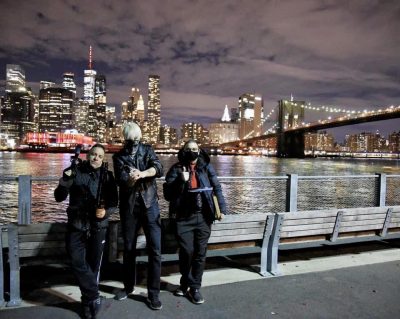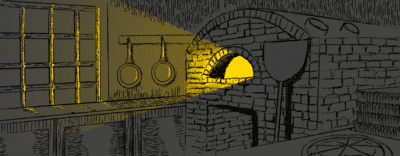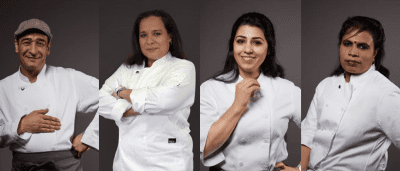Photo by Max Kalnitz
A thirst for ice: The quest to build New York’s first dedicated curling facility
Members of the Brooklyn Lakeside Curling Club, the only one of its kind in the city, are looking to build a permanent home for their sport
It’s a misty Wednesday evening in late February at the LeFrak Center at Lakeside in Prospect Park and Than Tibbetts is making the ice as favorable as possible for sliding 44-pound granite stones from one side of the rink to the other.
He and about 30 others are gathered to compete in Brooklyn Lakeside Curling Club’s winter league. The club offers competitive leagues twice a night on Wednesdays and Sundays as well as 90-minute curling lessons.
Tibbetts and teammate Miska Draskoczy are using backpacks filled with hot water to pebble the ice. They sprinkle water that forms droplets onto the ice that freeze instantly, giving the ice a bumpy texture. The pebbles not only allow the stones to attain the sport’s namesake “curl” motion but are the reason they can glide more than 20 feet without stopping.
With the ice ready, Tibbetts, the team skip, or captain, heads to one end of the sheet while his teammates take their positions on the other. The first few stones from both teams land just short of the house — the circular scoring area — and Tibbetts tells his team to throw the next one a bit harder. “The ice is frosty tonight,” he says. “It’s slowing down the stones. It takes a few throws to figure out the ice but it’ll smooth out.”
Brooklyn Lakeside Curling Club is New York City’s only club for local curling enthusiasts. But it’s a club without its own home: While members are thrilled to have a place like the Prospect Park rink to curl in the city, the conditions aren’t ideal. They share the space with hockey leagues and ice skaters, which affects ice quality. At curling facilities, special ice is made using a scientific process that accounts for the pH levels of the water, humidity, and the temperature of the rink, among other things.
Tibbetts compares a professional curling sheet to a putting green. Playing outdoors is more like the rough. It yields unpredictable conditions, especially this year due to New York’s unseasonably mild winter.
“[A real sheet of ice] is manicured within an inch of its life. It’s so level and so well prepped, Tibbetts says. “Everything matters as far as water quality, air quality, making sure there’s no drafts. You can see that all of that is not accounted for in an outdoor rink.”
That’s why Tibbetts and a handful of other members banded together in 2020 to launch a search for a venue. The goal is to build what will someday be called the Brooklyn Curling Center, a world-class facility that would put New York on the map as a curling hotspot.
“We really have a chance to become a destination for this growing sport,” says Tibbetts, who is leading the effort. “In the U.S. and Canada, the number one thing I hear when I talk to other curlers from different parts of the continent is, ‘Let me know when you guys are open! We’ve always wanted to travel to New York and go to a bonspiel.’”
Breaking the ice
Curling is one of the fastest-growing sports in the country. In fact, it’s growing so fast that most clubs can’t keep up with the number of people looking to try the sport.
USA Curling’s chief executive Jeff Plush told Market Watch last year the number of active curlers in the country jumped from 16,000 to 25,000 over the last decade, and that there are roughly 200 clubs across 49 states.
A USA Curling survey conducted in 2012 concluded that a third of all participating clubs were looking to build dedicated facilities and 70 percent of participating clubs showed an increase in membership. The organization partnered with North Carolina State University last year to conduct another survey to acquire updated data on curling’s growth and participation. Since 2020 at least eight new dedicated curling centers opened or began construction across the U.S. in major cities including San Francisco and Nashville.
What’s holding the sport back from growing even more is access to ice. Lakeside in Prospect Park is the only place in New York where curling is available but the Brooklyn Lakeside Curling Club’s capacity is capped at 120 members and most lessons this year sold out. Tibbetts says they can’t market the league or accommodate the multiple people who expressed interest in joining this year because of limited ice time and space.
Chad McMullan, one of the advisors on the project to build the Brooklyn Curling Center, has experience growing the sport across the world. As owner of Rock Solid Productions — a company that provides the synthetic used in Bryant Park — McMullan has helped introduce the sport to multiple countries including Mexico and Nigeria. He estimates Rock Solid has exposed the sport to more than two million students through schools, community groups, special events and more.
“There’s no shortage of people that desperately want to try it after seeing this crazy thing on TV, usually during the Olympics,” McMullan says. “Sheer population alone makes it basically a slam dunk; it would be a success in terms of participation and interest that’s 110 percent guaranteed … New York could have five curling clubs tomorrow and be successful let alone one.”
The problem most clubs run into, McMullan says, is finding a cost-effective space to house a facility.
Building something like the Brooklyn Curling Center is expected to cost between $5 million to $8 million. The goal is to find a space that accommodates six sheets of ice, a bar, and a restaurant.
The biggest obstacle so far has been working around structural columns. A curling sheet is 150 feet long and 15 feet wide. Organizers hope the eventual home for the Brooklyn Curling Center will be close to Prospect Park, but have looked at spaces in Gowanus and Bushwick. Some have had the space required for their operation but columns would prevent them from building the sheets of ice.
The goal is to begin construction before the 2026 Winter Olympics. The group hopes to lock in more investors with a crowdfunding campaign in the near future — and hopes that finally securing a location will motivate more investors, and curlers, to buy into the facility.
‘The spirit of curling is magical’
For people already interested in curling, having access to a dedicated facility in New York would be most welcome. Behind the push to build the center is the prospect of introducing it to even more people.
In addition to offering different level leagues and lessons throughout the week, Tibbetts envisions it becoming a place for corporate retreats, school or summer camp field trips, birthday parties, and fun nights out.
“You show curling to someone and they go, ‘I want to try that. I think I could do that,’” Tibbets says. “You quickly find out it’s not that easy. But it’s accessible. I can get you doing a really solid version of curling within 15 minutes. And you’re just off to the races. If it hooks you it hooks you. Like, we just don’t have people quit.”
The goal is also to tap into New York’s diverse population and introduce the sport to an audience that might not have had access to it before.
Husani Blaze, one of the proposed facility’s co-founders, recognizes this as an opportunity to increase the diversity of curling. Born in Jamaica and raised in Brooklyn, Blaze is one of a few Black curlers at the Lakeside club.
“Curling is a beautiful sport, the spirit of curling is magical,” Blaze says. “Unlike any other sport that I’ve ever been a part of, especially as a minority, I have never felt so welcome.”
In 2022 he helped establish the Jamaican Curling Federation, which is the first step towards creating a national team to compete in the Olympics. He hopes to make it to the Olympics one day. In the meantime, once the center is built, Blaze hopes he can make other people feel as welcome as he felt on the ice.
“For me this is a really important thing to exist because I can take it to kids where I grew up,” Blaze says. “Kids that would be interested but don’t even know that it exists or they’ve never seen anyone that looks like them play.”
You might also like 


























